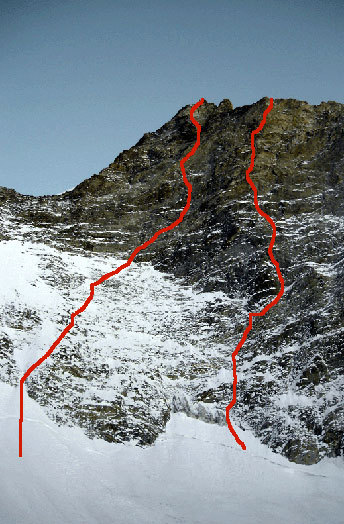
Racletteconection (M6, E3/4, 12 pitches, 700m), on the left, is the new route pioneered by Robert Jasper, Roger Schaeli and Bernd Rathmayr on the north face of Fiescher Gabelhorn (3875m), Bernese Oberland, Switzerland. The trio climbed the new line to make the mountain’s likely first winter ascent on March 13. Peter Jung and Hanspeter Trachsel climbed the marked line to the right (V 65 degree ice, 700m) in 1969. After encountering life-threatening rockfall, Jung and Trachsel advised against repeating their route, sending the mountain, located only a few kilometers south of the Eiger, into climbing obscurity. [Photo] Courtesy of Robert Jasper, Roger Schaeli and Bernd Rathmayr
In March I met two Swiss friends, Roger Schaeli and Bernd Rathmayr, and we packed for an alpine-style, direct attempt on the north face of Fiescher Gabelhorn (3875m), which lies eight kilometers south of the Eiger. The mountain rises above the longest glacier in Europe, the Aletsch Glacier, in the heart of the Bernese Oberland, Switzerland. Well-known Swiss climbers Peter Jung and Hanspeter Trachsel made its first ascent (V 65 degree ice, 700m) on July 28, 1969. Because of the dangerous nature of the climb, including life-threatening rockfall, Jung and Trachsel advised against repeating the route. This deterrent sent Fiescher Gabelhorn into obscurity for climbers (ski trekkers still skirt around the peak frequently), and the north face likely saw neither a winter ascent nor a direttissima to the summit before we arrived in March. Although we all had climbed the nearby peaks–the Eiger, Monch, Jungfrau, Aletschhorn, Gross Fiescherhorn, Finsteraarhorn and others–none of us had been to Fiescher Gabelhorn before.
We crossed the Aletsch Glacier on skis to reach the base of the face on March 12 and put up a small tent. The rocky face looked very steep, but it was difficult to see an obvious climbing line, and the approaching winter night left hardly any time to view it with binoculars. Later that evening, Roger spoiled us with a treat, Swiss raclette on the small gas stove.
The next morning at 5 a.m. we started up the lower ice field on mixed ground, hoping the line in our imagination would go. We climbed for an hour by headlamp and tied in at the base of the 500-meter headwall. We carried a full rack of friends, stoppers and some pitons, mostly knifeblades for the belay stations.
Following weaknesses up the face we shared the lead in three parts. I started the lead with four 60-meter pitches, Roger led the next four pitches and Bernd climbed the final four. The slabs were covered with thin ice, and the steeper parts were rockier and provided great mixed terrain. The difficulties were spread throughout the whole climb; most pitches were about M5, and the hardest ones were M6. We were glad we tried the face at the end of the winter season, when loose rock was frozen together with sufficient ice, making the terrain very climbable.
Without leaving any gear on the face, we topped out shortly before sunset in twelve hours. We reached the summit in cold winter conditions to finish Racletteconection (M6, E3/4, 12 pitches, 700m). After taking a short break, we downclimbed the south ridge and rappelled a couloir to the east. After a traverse to the Col before Wyssnollen (3595m) we rappelled in the dark to the west, then downclimbed to the Gruneggfirn Glacier. The descent took a total of four hours to reach our tent on the Gruneggfirn Glacier, and the next morning we skied back to Jungfraujoch in about six hours, having left no trace besides our tracks in the snow.
For me, our climb was important because I dreamt of this face ten years ago, when I was guiding the nearby peaks of Fiescher Gabelhorn. For us all, it was meaningful to find–and climb–a striking line in the Alps waiting for its first ascent.